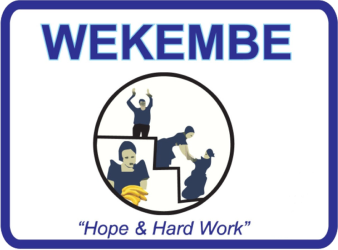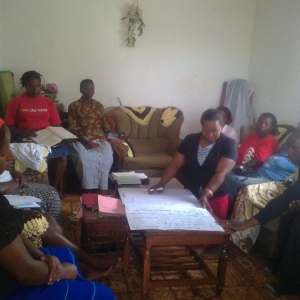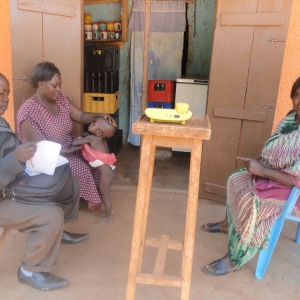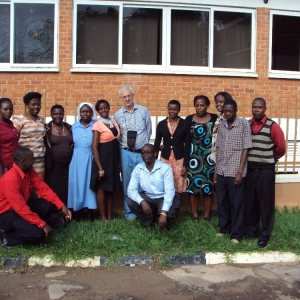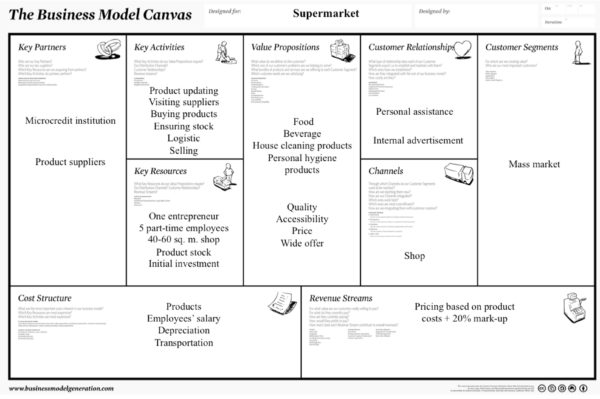The implementation of the model for a supermarket
The Business Model Canvas has been adopted to analyse and reproduce several business models operating in Uganda.
1. Description of the business
More precisely, the case study considered in this report concerns the investigation of a business regarding a service deliver as the supermarket.
The business model canvas reported in Fig. 1 represents the definition of a business, which has been realised by starting from the analysis of data concerning this specific successful business, managed by Luteete Josephine.
The aim of this business model canvas consists in defining and describing the successful factors characterising a supermarket, started in 2011 thanks to the first granted loan of Wekembe of about 1 million Ugandan schillings. Actually, the entrepreneur has received the second loan for 1 million Ugandan schillings. Principally the entrepreneur, supported by 5 part-time employees or 2 full-time collaborators, undertakes this business. She reaches at least monthly revenues for 15 millions Ugandan schillings and profits for 2,5 millions Ugandan schillings in a month.
The entrepreneur started this business by adopting a small shop. Due to the good performance obtained during the first years, she enlarged her business by building a bigger shop, close to the capital city Kampala, thanks to the financial sustainability from microcredit institutions. The potential for this business is good, but it is necessary to be competitive due to the presence of other 5 supermarkets in the same area.
2. Building blocks description
Customer segments
Clients who purchase at the supermarket are considered composing the mass market. The typology of products sold by the supermarket is wide and very different and this leads several varieties of people to buy common goods there. Buyers are considered also users, but this is not assured, because of the wide-ranging purchases a person usually performs in supermarkets. In fact, some clients buy products only for the sustainability of their children and others to satisfy the necessities of the whole family.
The potential for this business is good, due to the presence of copious loyal clients who purchase regularly and new customers who change the supermarket where to buy at or experiment this way to shop for the first time.
The good accessibility of the shop in the area of the capital city Kampala, ensures frequent visitors and regular purchases by people with good purchasing power.
Value propositions
The supermarket sells a wide variety of commodities necessary for everybody in their daily lives. Among these products it is possible to find primarily food and beverage in different assortments, detergents to clean house and clothes and products for the personal hygiene. Obviously, due to the greatness of the supermarket, it is possible also to find essential accessories for cooking and cleaning, such as kitchen utensils, basins and mops. Some of these commodities are displayed below in Fig. 2, 3 and 4.
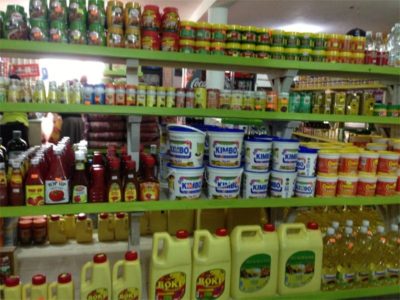
Fig. 2: Supermarket commodities
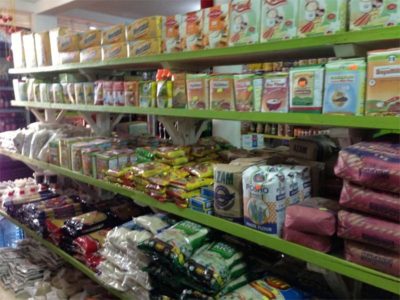
Fig. 3: Supermarket commodities (2)
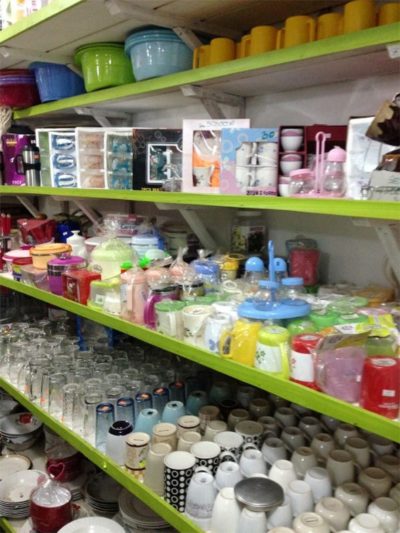
Fig. 4: Supermarket commodities (3)
The offered value to customers consists in the presence of high quality products at convenient prices. In fact, the supermarket has to keep prices equal or lower than competitors’ charges in order to retain loyal clients and attract new ones. The wide offer of commodities ensures good accessibility, especially to products that are not usual to find in small areas or villages. The huge size of the shop lets the entrepreneur sell some kinds of product in many varieties. As shown in the pictures above, the organisation of goods is accurate and coherent on the basis of complementary products, to stimulate the purchase and facilitate the finding of products for the final client.
Channels
The distribution of products occurs through a big shop, owned by the entrepreneur. She might begin the business by renting a small shop by using the loans received from microcredit institutions. If the business works well, the entrepreneur may think to buy the shop and enlarge her activity in the future.
The adoption of this channel is the most suitable for this business, due to the wide variety of products it is able to contain in a coherent order and the frequent flow of clients who visit the supermarket. Moreover, distributing products through a central shop ensures a good visibility and accessibility to all customers.
Customer relationships
The customer relationship developed with final clients is based on personal assistance through the service delivered by employees. In fact, the presence of collaborators inside the supermarkets allows consumers to ask for some information, receive suggestions about the adoption of goods and ask for restocking some missed commodities on the shelves. The ensured assistance from employees guarantees clients reassurance and promotes their visits to the supermarkets. It is important to keep personal relationships with clients, especially during the delivery of services.
The entrepreneurs might adopt some advertisement devices in order to promote the awareness of the shop among clients. One of these strategies consists in wearing a uniform, i.e. a t-shirt, with the name of the shop and its address written on the back. Employees, who wear this uniform during their working time, promote also the consciousness of the shop. An example of this advertisement is displayed in Fig. 5.

Fig. 5: The uniform with the supermarket generality
Revenue streams
Due to the frequency in purchases and the abundance in offered goods, the supermarket records high monthly revenues. The pricing of products consists in adding a 20% mark-up on each unit product cost; this method is substantially based on goods expenses as the starting item to identify the unit-selling price.
The entrepreneur’s account profits for nearby 2,5 millions Ugandan schillings each month. Considering fixed costs around 540,000 Ugandan schillings and the 20% of mark-up mentioned above, it is possible to approximately figure out monthly revenues for 15 millions Ugandan schillings.
The monthly profit amount comprises also the entrepreneur’s salary and the monthly depreciation of the shop that is not considered in the monthly cost analysis.
Key resources
The business requires the presence of the entrepreneur to manage most important decisions about the direction of the shop and run the entire activity coherently and synergistically. Furthermore, the employment of 5 part-time collaborators or alternatively 2 full-time employees is necessary to develop all the activities concerning the storage, the disposal of products on the shelves and client assistance.
A shop is required to have enough space to show all commodities. More precisely, the supermarket should have size between 40 to 60 square metres and more central is its location respect to the city centre and more the accessibility is ensured.
The stock of commodities is necessary to start the business and ensure the continuous availability of products to clients. Due to the frequent purchases, the refurnish of products in the warehouse and on the shelves is a prerequisite for this business.
The initial investment is necessary for the entrepreneur, especially to build the shop. For instance, to build a shop with the size mentioned above, it requires nearby 50 millions Ugandan schillings. Beyond the venture for facility, a consistent investment has to be spent to buy the first stock of products to equip the shop. Microcredit institutions might provide this amount of financial resources in order to stimulate entrepreneurial activities in poor areas.
Key partners
The main important partners to keep relationships with are commodities suppliers. The entrepreneur has to sustain relationships with almost 5 different suppliers in order to ensure wide variety of products that needs to be provided all the weeks. These suppliers might be present in the area close to the supermarket and this will facilitate the personal visit of the entrepreneur to make orders, at least twice a week.
As mentioned above, microcredit institutions are fundamental partners who ensure the financial resources and strategic suggestions in the preparatory steps to let the business start. Moreover, these organisations continue to support the entrepreneurs during the first years, in order to allow them to collect savings to self-finance the business in the future.
Key activities
Several activities are necessary to let the supermarkets work efficiently and with effectiveness. The entrepreneur has to be incessantly updated about suppliers’ offers in order to satisfy all clients’ requests and stimulate their purchases. As the supermarket delivers products to mass markets and due to the extent of this segment, the entrepreneur should push some new products with higher prices or be more aggressive than competitors to understand customers’ behaviour in specific situations.
The updating activity occurs also when the entrepreneur personally visit suppliers to order new stock. The continuous availability of stock inside the shop represents one of the most important offered values to clients, who preferably purchase all needed goods in one single moment.
After the visit, the order and the procurement of products occur. The entrepreneur negotiates the price of the provision and pays instantaneously the total amount of the expenditure.
Once the merchandise reaches the warehouse of the supermarket, employees dispose goods on the shelves with respectively tags with prices and promotions displayed on. They also manage delays in deliveries and collect post sales information to share with the entrepreneur, in order to keep them in consideration for next orders.
The product selling ends the circle of activity characterising the realisation of this business. The commodities sale occurs inside the shop during opening hours; a high service is always ensured to clients thanks to the unceasing assistance ensure by employees.
Cost structure
The cost structure of this business mainly considers fixed expenses, such as the employees’ salary and the costs incurred for transportation to visit suppliers 4 times each month. In fact, each employee receives a salary that might range between 60,000 and 150,000 Ugandan schillings. In order to make an approximation about the monthly total amount of costs the supermarket has to support, it is possible to set an average salary of about 500,000 Ugandan schilling paid for all the employees.
Furthermore, the entrepreneur, who visits the suppliers 4 times each month, has to pay nearby 40,000 Ugandan schillings for transportation.
Considering the total monthly revenues figured out above in the report and the amounts of profit and costs incurred each month, it is possible to evaluate the total expenses the entrepreneur pays for the whole provision. In fact, she spends about 12 millions Uganda schillings each month to ensure the availability of products on the shelves of her supermarket.
